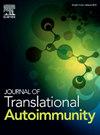通过生物信息学分析探讨系统性红斑狼疮和肺癌的共同生物标志物和机制
IF 3.6
Q2 IMMUNOLOGY
引用次数: 0
摘要
系统性红斑狼疮(SLE)患者表现出发展为肺癌的高风险,但其潜在的分子机制仍然知之甚少。本研究旨在利用基因表达综合(GEO)公开的转录组数据,确定连接SLE和LC的共同遗传因素。通过综合差异表达基因(DEG)分析和加权基因共表达网络分析(WGCNA),我们确定了5个在SLE和肺癌中持续上调的基因。基因集富集分析(GSEA)显示,这些共享基因在炎症通路中富集,特别是那些涉及干扰素- α、干扰素- γ和一般炎症反应的基因。我们应用最小绝对收缩和选择算子(LASSO)回归来确定潜在的诊断性生物标志物,并确定了两个关键候选物:AIM2和SLC26A8。这些生物标志物表现出稳健的诊断性能,在训练和验证队列中,ROC曲线下面积(AUC)值均超过0.75。使用癌症基因组图谱(TCGA)进行免疫浸润和生存分析进一步支持了它们的临床相关性。值得注意的是,AIM2高表达与女性肺腺癌患者较差的总生存率显著相关(P = 0.03), SLC26A8表达仅与吸烟史患者的生存结果显著相关(P = 0.01)。这些发现对SLE尤其有意义,因为SLE患者多为女性,吸烟是已知的危险因素。我们的研究增强了对自身免疫驱动癌变的理解,并为管理有肺癌风险的SLE患者的精准医学策略开辟了新的途径。本文章由计算机程序翻译,如有差异,请以英文原文为准。
Exploration of shared biomarkers and mechanisms in systemic lupus erythematous and lung cancer via bioinformatics analysis
Systemic lupus erythematosus (SLE) patients exhibit a heightened risk of developing lung cancer, yet the underlying molecular mechanisms remain poorly understood. This study aimed to identify shared genetic factors linking SLE and LC using publicly available transcriptomic data from the Gene Expression Omnibus (GEO). Through integrated differentially expressed gene (DEG) analysis and weighted gene co-expression network analysis (WGCNA), we identified five genes consistently upregulated in both SLE and lung cancer. Gene set enrichment analysis (GSEA) revealed that these shared genes were enriched in inflammatory pathways, particularly those involving interferon-alpha, interferon-gamma, and general inflammatory responses. We applied least absolute shrinkage and selection operator (LASSO) regression to pinpoint potential diagnostic biomarkers and identified two key candidates: AIM2 and SLC26A8. These biomarkers demonstrated robust diagnostic performance with area under the ROC curve (AUC) values exceeding 0.75 in both training and validation cohorts. Immune infiltration and survival analyses using The Cancer Genome Atlas (TCGA) further supported their clinical relevance. Notably, high AIM2 expression was significantly associated with poorer overall survival in female lung adenocarcinoma patients (P = 0.03), and SLC26A8 expression was significantly linked to survival outcomes only in patients with a history of smoking (P = 0.01). These findings are particularly meaningful in SLE, where most patients are female and smoking is a known risk factor. Our study enhances the understanding of autoimmune-driven carcinogenesis and opens new avenues for precision medicine strategies in managing patients with SLE at risk for lung cancer.
求助全文
通过发布文献求助,成功后即可免费获取论文全文。
去求助
来源期刊

Journal of Translational Autoimmunity
Medicine-Immunology and Allergy
CiteScore
7.80
自引率
2.60%
发文量
33
审稿时长
55 days
 求助内容:
求助内容: 应助结果提醒方式:
应助结果提醒方式:


